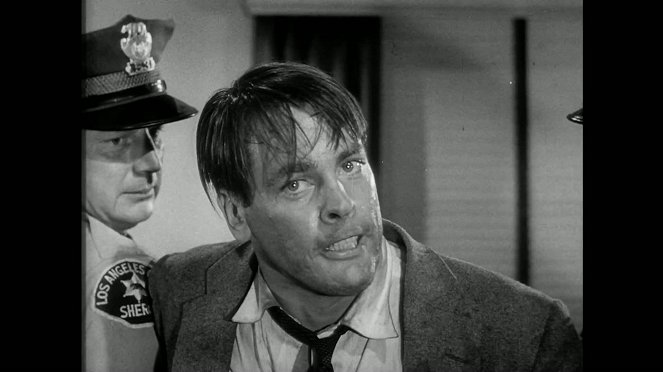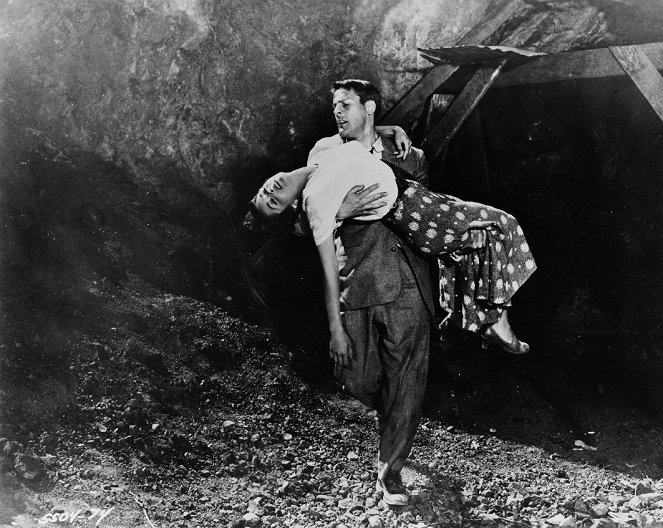Director:
Don SiegelCámara:
Ellsworth FredericksMúsica:
Carmen DragonReparto:
Kevin McCarthy, Dana Wynter, Larry Gates, King Donovan, Carolyn Jones, Jean Willes, Ralph Dumke, Virginia Christine, Dabbs Greer, Kenneth Patterson (más)Streaming (1)
Sinopsis(1)
El Doctor Miles Bennell regresa a su ciudad tras una conferencia, y se encuentra con algunos pacientes y conocidos que dicen no reconocer a algunos de sus familiares, ya que su comportamiento es completamente distinto al que conocían. Achacado todo a una especie de paranoia colectiva, el Dr. Bennell irá descubriendo que tras ese fenómeno se esconde algo que jamás hubiera podido imaginar y que amenaza las vidas de todos los habitantes del planeta. (Filmin)
(más)Videos (1)
Reseñas (5)
Poster tagline: THE NIGHTMARE THAT THREATENED THE WORLD! An incredible intense sci-fi blockbuster that was a generation ahead of its time with its expressive language and lack of naivety. If I had to name a film that best encapsulates the paranoid McCarthy era, in which fear of creeping communism was paramount, I would name two: Clooney's Good Night, and Good Luck and this sci-fi movie that will make you forget the Ed Wood-like dumbness of that era.. Particularly in the second half, the plot builds up fantastically, and the ending? Don Siegel had the balls to leave it open and without a happy ending; unfortunately the studio, Allied Artists, got scared and "softened" the result with forced touches. Still, it doesn't discourage me from giving it a maximum rating, because this movie is unique in the flood of genre-related films. Perhaps because a yet to be famous Sam Peckinpah helped with the script. Kaufman's 1978 remake is also unexpectedly brilliant.
()
A superb invasion horror flick from the fifties that none of the remakes can hold a candle to. Unsettling, depressive and wonderfully made. Unlike others, the hints of a happy end didn’t piss me off. Somehow, I even wanted it.
()
Once you start having doubts... It’s as if the disillusionment of film-noir has shifted from the big cities to the suburbs. Like post-war American society, preventively haunted by spies from the East and the atomic bomb. A unified consumerist society. The first major critical success achieved by Peckinpah’s mentor, Don Siegel, is sadistically disturbing due to the fact that it explains nothing. He doesn’t use his depiction of the mood in society for the purpose of making transparent anti-communist agitprop. Instead, he places innocent situations that were surely familiar to Americans at the time, such as backyard barbecues, in a deliberately vague context, thus forcing viewers to figure out for themselves what is wrong, and what is wrong with the viewers themselves. The rational explanation that the characters seek from the start is non-existent. Try explaining fear. Where a psychologist cannot cure an individual, no institution can help society. They are all in on it and anyone who tries to get out of it will be taken as a fool. The confining atmosphere is due in part to the camerawork, which intrudes on the characters’ personal space, and the use of locations that minimise the chance of escape (corridors, narrowing streets). The occasional naïveté and half-baked nature of Invasion of the Body Snatchers is amusing today, but these aspects are not so frequent and conspicuous that they would negatively affect the film’s astonishing momentum, a third of which is derived from the unceasing escape from the situation that people found themselves in at the time. And actually not only then. 85%
()
The US is considered to be the promised land of science fiction, and the golden era of American sci-fi literature in the 1930s and 1940s found its continuation in the film industry, where a number of B-movies emerged in the early 1950s, taking advantage of the contemporary hysteria about flying saucers and alien invasion of Earth. Invasion of the Body Snatchers represents one of the peaks of the genre within these productions, remaining impressive and fully usable even years later. This is because Don Siegel did not focus on effects and sets, which usually become outdated after a few years, but on the paranoia of the protagonist, who realizes before others that he is facing a mortal threat but doesn't know how to stop it. The camera is constantly focused on the main character, capturing his increasing nervousness, fear, pain, and exhaustion. This film is about the despair of a person who knows he is losing his loved ones. Siegel's film has two interpretations - the first, more common one, claims that the film is a depiction of the paranoia of the Cold War era and the fear of advancing communism with its uniformity and massiveness. A minority holds the opinion that Don Siegel simply criticized the decline of traditional American individualism and the emergence of a conformist society, where opinions and value hierarchies are created by mass media and state institutions. Personally, I prefer Philip Kaufman's 1977 remake, which lacks the B-movie patina of the 1950s and has a more balanced and distinctive cast. Overall impression: 75%.
()
The theme of post-war trauma and the great crisis of individuality. The embodiment of paranoia from an open and uncertain world that replaces our familiar space (space exploration, the Cold War, a phantom threat "from the outside"). Invasion of the Body Snatchers is a pop-culturally edible metaphor for the demise of humanity and the continuing decline of civilization, all whilst incorporating a ubiquitous vision of a threat from the other side that cannot be described more accurately (because it is partly a utopian construct of power). Don Siegel shot an excellent sci-fi thriller with the means he had at the time, without the exaggeration and naturalism of later years. An organically flowing film without brutality and flashy effects, which reaches breathtaking heights, especially in the finale. The power of the image and the overacting of the main characters, all amplified by the kitschy shallow music. The feeling of threat and the absence of a safe haven only intensifies it, unlike Kaufman's later version with Donald Sutherland. While there is a "danger" in the film that is somehow unmotivated and anonymous, Siegel's classic clearly names it. Despite the fact that it comes from the stars, it slumbers mainly within us. It is through this that this black-and-white version stands out from the later ones. 90%
()



Anuncio